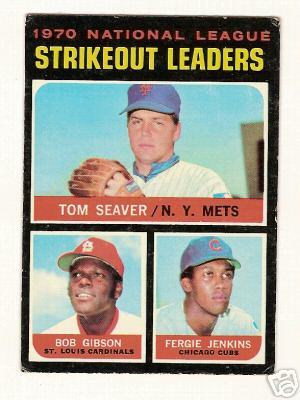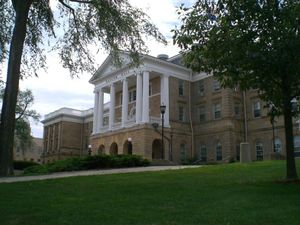Tom Seaver was the dominant pitcher of my youth. In an era surrounded by Hall of Fame pitchers and 300-game winners not seen since the deadball era, Tom Seaver to me stood above the crowd. Sure, Steve Carlton and Bob Gibson and others had their supporters, but they were just wrong. Bob Gibson told me to do something to myself that was physically impossible when I asked him for his autograph, how could he possibly be better than Tom Terrific?
Fellow CP David R. Michaels recently wrote an article on the five greatest pitchers in history. He followed that up with another piece, naming six more pitchers. Now, these pieces are subjective by nature. Where someone ranks could depend on if you favor peak or career performance. Plus, it depends on if you think wins or strikeouts or innings or ERA is the most important thing for a pitcher.
But David made one choice in his second list that I feel leaves the realm of subjectivity and enters into the area of incredulity. He mentioned Bob Gibson on his second list and did not have Tom Seaver on either. Could my childhood memories be wrong? Let’s look at the numbers and see how Bob Gibson and Tom Seaver compare to each other.
Both Bob Gibson and Tom Seaver were right-handed power pitchers. Their careers overlapped many years, when both pitched in the National League. Both pitchers were mainstays on the All-Star teams, although Tom Seaver was selected in 12 years while Bob Gibson had eight. Here’s how they rank in basic categories:
IP Record SO ERA WHIP Bob Gibson 3884.1 251-174 (.591) 3117 2.91 1.188 Tom Seaver 4782.2 311-205 (.603) 3640 2.86 1.121
This is a decisive win for Tom Seaver. Bob Gibson made his Major League debut as a 23-year old and pitched until he was 39. Tom Seaver made his debut as a 22-year old and pitched until he was 41. It wasn’t until his third season in the Majors that Bob Gibson established himself as a full-time player. Tom Seaver made 34 starts in his first year. Bob Gibson had his last full year as a 38-year old. Tom Seaver was an effective pitcher through his final season.
Tom Seaver got an earlier start and was effective longer than Bob Gibson, helping him post more impressive counting numbers (wins, strikeouts, innings). But Tom Seaver still had better rate numbers than Bob Gibson, compiling a lower ERA, a lower WHIP (walks and hits per nine innings) and a higher winning percentage.
Everyone knows about Bob Gibson’s magical 1968 season. Perhaps he enjoyed a better peak than Tom Seaver? Here are their top seasons in wins, along with strikeouts and ERA for those years.
Bob Gibson
1970 23-7 – 274 – 3.12
1968 22-9 – 268 – 1.12
1966 21-12 – 225 – 2.44
1969 20-13 – 269 – 2.18
1965 20-12 – 270 – 3.07
Avg 21-11 – 261 – 2.38
Tom Seaver
1969 25-7 – 208 – 2.21
1975 22-9 – 243 – 2.38
1977 21-6 – 196 – 2.58
1972 21-12 – 249 – 2.92
1971 20-10 – 289 – 1.76
Avg 22-9 – 237 – 2.46
Another way to look at peak is to examine ERA+, which normalizes for home park and run-scoring environment. Here are the top 10 seasons for each:
Bob Gibson 258, 164, 151, 148, 139, 137, 133, 132, 127, 126
Tom Seaver 193, 175, 165, 150, 145, 142, 140, 137, 136, 127
Bob Gibson had the standout 1968 season, but Tom Seaver was better in every single other season by this metric.
Any definition of peak that lasts more than one year, the difference between Bob Gibson and Tom Seaver is microscopic and one can twist the numbers to support whichever candidate one wishes.
Tom Seaver and Bob Gibson went head-to-head 10 times in their careers. Tom Seaver emerged with a 6-2 record in those games (Gibson: 2-6). Bob Gibson won the first two games in the series, including an electrical matchup the first time they ever faced one another in 1968, when he won a 2-1 game in 11 innings when both pitched complete games.
There are two other things to keep in mind in making the comparisons. One is that while their careers did overlap, Bob Gibson started earlier and the prime of his career matched up perfectly with the greatest pitching era since the introduction of the live ball. Bob Gibson’s age 27-32 seasons came from 1963-1968, when offensive levels were at a supreme low.
Tom Seaver only got to pitch two seasons in this time, and they came when he was 22 and 23. Tom Seaver’s best season, at least in terms of wins, came in 1969, the year they lowered the mound five inches and the size of the strike zone was reduced. It is fun to think about how dominant Tom Seaver could have been under the old conditions!
The other thing to remember is that Bob Gibson pitched on perennially good teams with the Cardinals. Only four times in Bob Gibson’s career did St. Louis finish under .500 and one of those came in his first year in the league when he made just nine starts. Additionally, six times his teams won 55 percent of their games, meaning they were one of the top teams in the league. The Cardinals played in three World Series during Bob Gibson’s tenure.
Meanwhile, Tom Seaver’s squads finished under .500 eight times and four other teams nosed over .500 simply due to Tom Seaver’s efforts. Bob Gibson never played on a team as bad as the 1967 Mets or the 1983 Mets or the 1982 Reds or the 1968 Mets. Those four teams lost a combined 385 games. Bob Gibson’s four-worst squads lost 331 games. Only four of Tom Seaver’s teams won 55 percent of their games. Tom Seaver played in the World Series twice.
No mention of Bob Gibson is complete without referencing his outstanding post-season record. In nine World Series games, he was 7-2 with a 1.89 ERA. He fanned 92 batters and allowed just 17 walks in 81 innings. He was the World Series MVP in both 1964 and 1967. The only black mark on his record was losing Game 7 of the 1968 World Series, when he gave up four runs in a route-going performance.
Bob Gibson has three things in his favor – his sparkling 1968 season, his World Series performance and his lifetime batting – to suggest he was better than Tom Seaver.
But there is no way that makes up for Tom Seaver’s 900 additional innings pitched and 60 extra wins. Basically, one has to add Bob Gibson’s three best seasons onto his 17-year career just to match Tom Seaver’s lifetime record. And this is not even taking into account that Bob Gibson performed in a better environment for pitchers and on better teams.
So, my childhood memories are safe. Tom Seaver was the better pitcher. Now I can look forward to the day when I go to a card show, pay my $25 for an autograph, walk up to Bob Gibson and tell him what he told me. That would be fun.
Reference:
- All stats from baseball-reference.com


